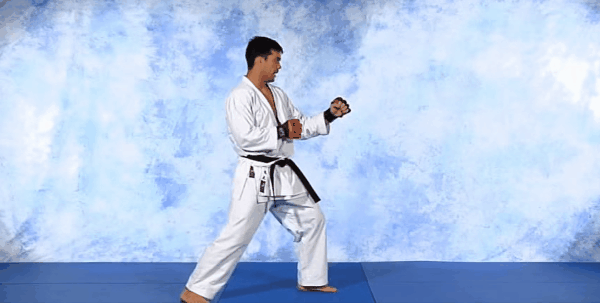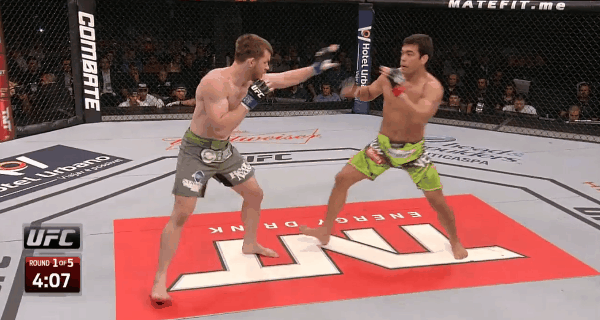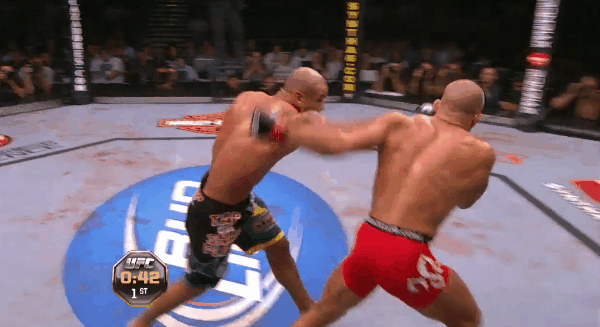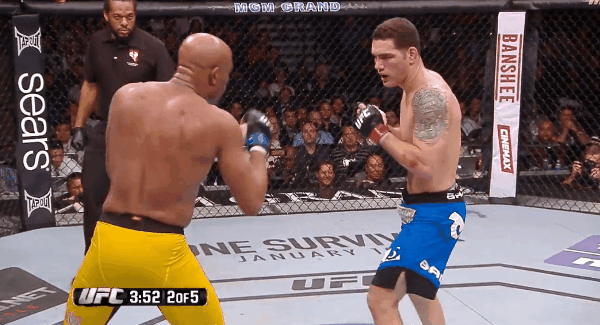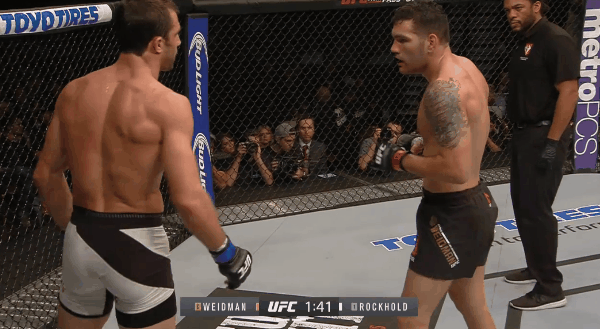MMA Basics: Kicking
Photo by Jeff Bottari/Zuffa LLC/Zuffa LLC via Getty Images
Kicks are among the most spectacular and exciting techniques seen inside the cage. Whether it’s a series of crushing low kicks hobbling fighters’ movement, a highlight reel head kick KO, or a brutal liver kick few things bring fans out of their seats like good kicking.
But in the context of MMA kicks are also very risky; a caught kick can lead to a takedown and extended time on bottom, and getting a kick countered by punches in 4 oz gloves is no picnic. So what kicking techniques have been successful in MMA, and how do kickers deal with the threat of being countered? In keeping with the MMA Basics theme, this article will provide a high level overview of how kicking works in MMA in order to give the newer fan some context when watching fights and listening to commentary. First things first, let’s discuss where kicking in MMA comes from and how fighters’ base styles impact the shape of their kicking games.
Origins
While kicking is not unique to Asian martial arts (France’s Savate is a few hundred years old and was briefly an Olympic sport), most of the kicking seen inside the cage comes from one of two stylistic families: Karate and Muay Thai. ‘Karate’ for this purpose includes the many styles of Okinawan and Japanese karate as well as Chinese wushu/kung fu systems (including San Shou) as most have similar methods and philosophies for attacking with the feet. Korean arts such as Tae Kwon Do and Tang Soo Do also fall into this category as TKD is basically a Koreanized form of Japanese karate (arguments that it’s actually a 2000 year old indigenous Korean system are more nationalistic than historical). Kicks in these styles tend to generate power with snapping motions for both roundhouse and front kicks, and the kicker is generally pivoting in place rather than stepping prior to the kick. Low kicks are not historically a big part of these styles’ arsenal, with the exception of the full contact Kyokushin karate system and some Chinese styles such as Wing Chun. These styles also feature dynamic spinning kicks which are among the most surprising and dangerous weapons kickers can utilize.
The other major kicking art to make an impact in MMA is Muay Thai (a stylistic family that includes the Burmese art of Lethwei). Kicks in Muay Thai are not snappy, rather fighters treat the leg more like a baseball bat being swung at the target from the kicker’s hips. There’s not really any snap of the lower leg, instead hip rotation and weight shifts generate the power, often with a small step to the side as the kick starts to create momentum and weight transfer into the target. Many analysts and commentators associate Muay Thai with low kicking and that’s certainly part of the style, but the highest scoring kicks in the big stadiums of Rajadamnern and Lumpinee (the premier venues for Muay Thai) are actually body kicks. Thai style roundhouse kicks to the body don’t cut a wide arc like a karate kick, instead rising from the canvas in an almost straight upward trajectory before being turned over at that last minute into the opponent’s gut. It’s an over-generalization, but not completely wrong to think of Muay Thai kicking as placing a premium on power over precision whereas karate kicking favors the latter.
The final style that deserves mention is the hybrid Dutch/international kickboxing. This is the style you’ll see when you watch organizations like K1 or Glory. It’s an amalgamation of Western boxing and karate kicking that has been heavily influenced by Muay Thai over the years as Thai athletes have sought bigger purses outside their home country and often dominated their Japanese and European rivals with their brutally powerful kicking and kneeing games. Kicking in international kickboxing can look very Karate or very Muay Thai depending on the fighter, and this is the arena where low kicks really caught on as there’s a natural synergy between boxing in combination and throwing hard kicks to the legs. Many Japanese fighters of the PRIDE era up through today have practiced and fought within this style, and you also see its influence among Europeans many of whom learn to strike from Dutch style kickboxing coaches.
So if those are the broad styles that contribute to kicking in MMA, in what ways do they appear different inside the cage? How can you guess from watching a fighter kick if he’s more likely got a wall of point karate trophies at home or did a few stints at Fairtex? To answer that we’ll go to the tape.
Techniques
The most basic kick that you see across styles is the roundhouse (for this article I’ll stick to the Anglicized terminology you’ll likely hear in MMA commentary rather than reeling off the Japanese, Korean, Chinese, and Thai names for each kick). This kick is characterized by the leg coming into the target on an arc as the kicker pivots on the ball of his foot, and can target anywhere on the body from the lower calf to the head. It’s also a kick with a clear difference in execution between Karate and Muay Thai stylists. Let’s take a look at how you might see it thrown by a Karateka first.
Karate expert Lyoto Machida demonstrating the roundhouse kick in a training video. Notice the characteristic snap at the end of the technique.
Contrast that with a characteristically Thai style roundhouse as shown here by multiple time Lumpinee champion Sam-A Gaiyanghadao:
Sam-A takes a small step to his left to open his hips in his preparation to kick. When he does kick the leg comes up almost vertically from the floor hitting the bag at an upward angle. Notice that while his leg is slightly bent to ensure relaxation and facilitate speed, there’s no snap on the end of the kick. All the power comes from the hips driving up and across the target. Observe too how the striking surface is the lower shin, not the foot. Thais always kick with the shin on roundhouses as the foot is more easily broken by an errant kick to the elbow.
In Muay Thai, roundhouses scores even if they hit the opponent on the arms and gloves. Only a check (a block with the shin) neutralized the score under stadium rules. Combined with the highly conditioned shins Thais achieve by kicking bags and pads thousands of times a day from a young age (taking out banana trees is a result of this training, not how you get conditioned shins in the first place) Nak Muay are happy just to slam kicks into opponents’ blocks uprooting them and taking away their ability to fire back with punches, whereas Karate fighters are usually aiming to deliver a precise, fight ending blow in keeping with Karate’s ‘one shot, one kill’ philosophy. You can see how the difference manifests in fights. Let’s look at one of Lyoto Machida’s many great KOs in the UFC to see what precision and power can do to a hapless opponent’s liver, in this case TUF standout CB Dolloway’s.
Machida comes forward and Dolloway raises his guard to defend against a possible punch blitz. In this instance it was a bad read as Machida launches a snapping roundhouse kick up under Dolloway’s guard into his liver. The rest is academic as Dolloway is too paralyzed by the kick to do more than curl up in defense. The availability of the power roundhouse kick to the liver is one reason you will see more southpaw stances in kicking styles even from fighters who are naturally right handed. It is not unusual for a right handed fighter’s left kick to be more powerful than their right kicks as the strength of the standing leg is more important for power than the strength of the kicking leg itself.
While Thai stylists certainly can kick with precision, it’s equally impressive to see how effective a kick can be when power and conditioning are simply turned up to 100.
Left kick legend Samkor in against Japanese kickboxer Satoshi Kobayashi. Kobayashi had dangerous hands, but it didn’t matter once Samkor started getting off his left kicks. Here he comes over the check and slams his shin into Satoshi’s arm. Notice how the kick throws Kobayashi off balance lifting him out of stance. This makes it almost impossible for him to counter as you can see by the irrelevance of the left hook he tries to throw after the third kick in the sequence. Samkor is intentionally hitting the arm here to keep Satoshi’s hands at home and cripple his punching power. Once Kobayashi is on the ropes and focused only on the kick to his arms, Samkor goes low for the knockdown.
The roundhouse to the body is seen a little less often in MMA than in kickboxing or Muay Thai as there’s a higher price to pay for failure. Getting a kick caught in Muay Thai results at worst in a sweep or counter kick that lets your opponent rebalance the scorecards. in MMA however, you can end up on your back for an extended period of time after just one poorly set up kick gets caught. As such, it’s more common to see low kicks and head kicks in the cage as both are harder to effectively counter. Low kicks have a long history in MMA, from Marco Ruas’s early leg kick KO of Paul Varelans to Jose Aldo’s legendary beatdown of Urijah Faber.
At the end of the third round in their classic WEC title fight Jose Aldo stalks Faber up against the cage. Faber had grown wary of the leg kick by this point and had become reluctant to put too much weight on his front leg, but his wrestle boxer style demanded that he do so to be able to come forward. Seeing Faber with weight on the leg, Aldo unloads a right low kick stumbling his opponent and forcing a temporary stance switch. Note the very small, quick step Aldo takes to his left prior to the kick. This loads his hips and adds significant power to the kick. Aldo also drops his weight as he kicks ensuring the full force of his 145 lb frame slams into Urijah’s thigh. In interviews Faber has said he still has nerve damage in his leg as a result of this fight.
Roundhouses are the most common kicks we see in the cage, but others do make an appearance from time to time. The front kick has not been as commonly seen in MMA, but in the hands of the right fighter it’s effective as both an attritive body attack or a fight ending kill shot to the head.
In one of the all time gutsiest performance in UFC history, the first fight between Yoel Romero and Robert Whittaker, Bobby Knuckles ignored his damaged knee to land repeated front kicks to Romero’s body. Here the ageless Cuban phenom ducks into a front kick while punching after which Whittaker quickly follows up with another snapping blow to the midsection. The snapping nature of these kicks, especially the second one, make it very difficult for Romero to catch the foot and capitalize on Whittaker’s attack.
Anderson Silva at the peak of his powers. Head feints from the Spider make his opponent Vitor Belfort wary and slow to react. Sensing the moment (and without breaking eye contact), Silva throws a snapping front kick straight up the middle instantly KOing Belfort and retaining his UFC MW title.
The Muay Thai version of the front kick, the teep, is seen far less in MMA than its Karate counterpart. The reason is that the teep in Muay Thai usually comes from a heavily back weighted stance that is less useful in MMA due to the threat of the takedown (it’s hard to sprawl when most of your weight is on your back foot), and the teep is generally used as a defensive weapon to halt a fighter coming forward looking to punch or kick. In mixed martial arts where that fighter coming forward can catch your teep and run through to take you down the trade off of risk to reward simply doesn’t favor the pushing front kick.
The roundhouse and front kick are likely to remain the predominant kicks seen in MMA because they require relatively little commitment to throw and don’t entail a lot of vulnerability on the part of the kicker. There are however other flashier kicks that offer greater potential for instantly finishing your opponent but that open the kicker up to more dangerous counters. The two techniques that best fit that bill are the spinning kicks, the spinning back kick and the wheel kick. These moves are rarely seen in Muay Thai, but exist in the arsenal of most Karate and kung fu stylists (the spinning back kick being especially common in San Shou). When they work, they’re a thing of beauty.
In an instance of very bad timing, Mousasi ducks for a takedown or to avoid an anticipated wheel kick directly into Uriah Hall’s jumping spinning back kick. The follow up flying knee adds both insult and injury to the damage already done.
Officer, I’d like to report a murder. In an all time iconic KO, noted kicker Edson Barboza sends Terry Etim to the shadow realm with a picture perfect wheel kick.
Counters
Kicking in MMA is great. The leg is the largest, strongest weapon a fighter can throw at his opponent, and even a blocked kick can have a significant impact on a fight. So why don’t we see fighters engaging in Bloodsport-esque back and forth kicking battles? The reason is that while kicks are extremely powerful, they also entail more risk than punch- and clinch-centric approaches to MMA. Kicks can be caught, checked, or in the case of spin kicks the kicker can simply get rushed in the middle of the turn and end up on the wrong end of a beating.
GSP never worried too much about checking kicks because he was so good at catching them and taking his opponents down. Here dangerous striker Thiago Alves comes in with a barrage of strikes culminating in a low kick. St. Pierre is ready for the finish however, and catches/knee taps the kick into a takedown. Alves would end up spending most of the fight on the bottom as GSP hit repeated takedowns, many off of caught kicks.
Catches aren’t the only danger for kickers. While checking kicks (blocking a kick with your shin) is much less common in MMA than in kickboxing or Muay Thai, it is also true that MMA fighters typically don’t have the same level of shin conditioning as pure strikers. As such, when up against an opponent who does check regularly, there’s a non-zero risk of seriously damaging your own leg by throwing kicks. One of the most gruesome examples in MMA history comes from the rematch between Chris Weidman and Anderson Silva for the MW championship.
After getting caught clowning in the first fight, Anderson Silva came into this rematch a man on a mission. After having several low kicks checked by the well prepared Weidman however, the Spider should have thought twice about naked low kicks. The low kick to the inside thigh is especially easy to check since the defender’s leg is often turned somewhat in already, and the champion times this check perfectly. The ugly break of Silva’s ankle wasn’t likely to happen, but it also wasn’t an accident.
Chris Weidman has also found himself on the wrong end of some kick attempts, most notably in his title tilt with (excellent kicker himself) Luke Rockhold.
After competitive early rounds, Weidman throws a lazy wheel kick with no setup against Luke Rockhold in their 2015 title contest. Rockhold simply steps in and body locks the champ, resulting in a takedown and follow up beating that should have ended the fight (and did set up Rockhold’s stoppage win in the subsequent round).
Final Thoughts
Kicking has been a part of mixed martial arts since the beginning. Whether it’s crippling low kicks, crushing roundhouses to the body, jumping head kicks off the cage, or spectacular spinning attacks every fan loves to watch a good kicker in action. But kicking does carry risk, and any fighter who wants to make kicking a core part of his or her arsenal needs to work on their setups and defending against common counters. In the right hands however, there’s nothing more aesthetically pleasing than a great kicking game.

